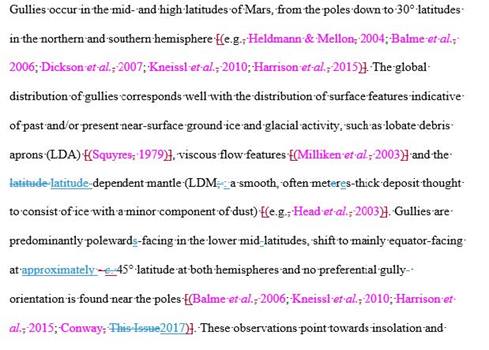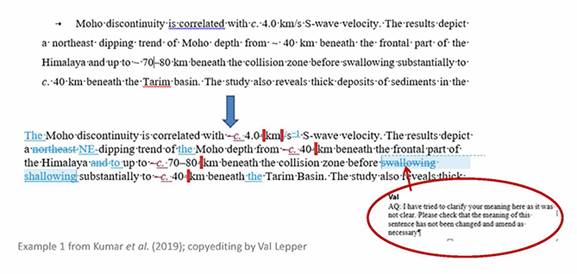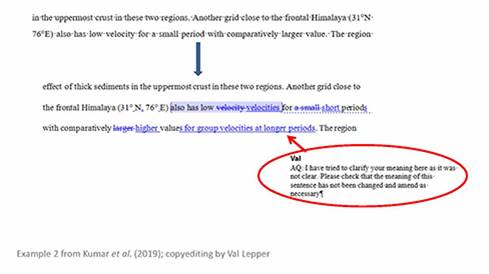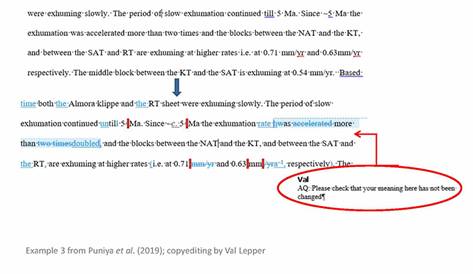Based on an original presentation from the Production Team for Geological Society of London Editorial Board members and Editors, highlighting what the pre edit and copyedit processes do to an accepted manuscript.
Inserts basic GSL style, e.g.
The various parts of references are tagged during the pre-edit stage. This allows the typesetter and copyeditor ensure they are correct. Different colours are used for the authors’ surnames, authors’ first initials, year, article title, etc.
References are also updated to follow GSL guidelines and be consistent. Here, the full journal name is inserted.
The copyeditor is the first person to read the paper all the way through once it has entered production. They look at a number of elements
Every science publisher will have their own house style: The order of elements included in a reference; whether a reference citation in the text is a name-date or a number citation; what a figure caption looks like; how many rules (lines) a table has; what a list looks like and so on.
GSL has a 60-page style guide that our copyeditors are familiar with and they will read each pre-edited file and ensure that the paper and its contents adhere to GSL style.
Editorial Board members and Editors should not worry if a submitted article is not in GSL style
Language, spelling and grammar
Copyeditors will read each paper for language and improve the text if necessary, for clarity, non-native English speakers etc. They will always raise a query to the author when altering any of the text so that the author can clarify or request a change back. They will deal with any spelling errors, ensure that language is inclusive, amend US English to UK English and check the grammar, amongst other things.
If Editorial Board members and Editors think the science in a paper is understandable but the English in need of improvement, we can deal with that. If there are typographical and punctuation errors, we can deal with those.
Sense, inconsistencies
Copyeditors will read each paper for sense. Although the science is high level, it’s relatively clear when something is missing from a sentence, or if there’s potential duplication. We will raise a query to authors. The copyedit also checks for consistency of terminology, capitalization of terms and italicization. We ensure that if an author uses an abbreviation that this is defined at first use.
Editorial Board members and Editors should not worry if a submitted article is not consistent in its use of capitalization etc.
Figures, tables and their captions
Copyeditors check the figures and tables as they read through the text. They will ensure that: if a figure has abbreviations, these abbreviations are explained in the caption; if abbreviations are listed in the caption they can be found on the figure; that terminology used on the figure is consistent with that used in the text. Similarly, if a table contains acronyms or abbreviations, they will ensure these are explained in a table footnote. If the text mentions a place name in relation to a figure, they will check that the place appears on the figure and so on.
Editorial Board members and Editors shouldcheck that figures illustrate what the author intends and tell the PE: if N (north) needs to be indicated; if axes are labelled adequately etc.
Queries
Copyeditors will resolve queries that the pre-edit generates, if they can. These will often be things like inconsistent spelling between a reference in the reference list and its textual citation. They will generate new queries too as they read through the article. We try to limit the number of queries that go to authors on the proofs so that they are not too overwhelming.
We will always query authors when we make major changes to their text, so that they are aware of any alterations that may affect their intended sense.
Section of a copyedited paper
This is an example of what a pre-edited, copyedited piece of text looks like (from de Haas et al. 2017). The pre-edit (red editing) has taken care of some style issues (square brackets to parentheses, deletion of comma between name and date in the reference citations); the copyedit (turquoiseediting) has changed US to UK spelling of ‘metres’, added an adjectival hyphen, replaced ‘This Issue’ with the date of publication and so on. The pink indicates a hyperlink will be inserted.

Language editing: example 1
This is very subjective . It can be quite tricky for Editorial Board members to judge whether they should accept a paper or send it back for further revision and there are no hard and fast rules. As an aid, we include three examples of language editing.

Language editing: example 2

Language editing: example 3

As an Editorial Board member, you don’t need to
- Worry about GSL style points
- Insist the author puts everything into style
- Check that all the citations are listed* and vice versa
- Worry about grammar
- Worry about consistency of spelling and terminology
*Unless, of course, you want to be able to check out all the authors’ citations and read the original sources yourself before accepting a paper.
You can concentrate on The Science
- Is the science understandable but the language in need of tidying up?
- Does GSL style need imposing?
- Are there inconsistencies in terminology?
- The copyedit and pre-edit will sort these.
- We will always add a query to the proofs if we alter anything and are unsure if we’ve interpreted the author correctly.
Copyediting
Now you can put your pen away and put your feet up and leave the rest to us

References
de Haas, T., Conway, S.J., Butcher, F.E.G., Levy, J., Grindrod, P.M., Goudge, T.A. and Balme, M.R. 2017. Time will tell: temporal evolution of Martian gullies and palaeoclimaticimplications. In: Conway, S.J., Carrivick, J.L., Carling, P.A., de Haas, T. & Harrison, T.N. (eds) Martian Gullies and their Earth Analogues. Geological Society, London, Special Publications, 467, 165-186, https://doi.org/10.1144/SP467.1
Kumar, N., Aoudia, A., Guidarelli, M., Babu, V.G., Hazarika, D. & Yadav, D.K. 2019. Delineation of lithosphere structure and characterization of the Moho geometry under the Himalaya–Karakoram–Tibet collision zone using surface-wave tomography. In: Sharma, R., Villa, I.M. & Kumar, S. (eds) Crustal Architecture and Evolution of the Himalaya–Karakoram–Tibet Orogen. Geological Society, London, Special Publications, 481, https://doi.org/10.1144/SP481-2017-172
Puniya, M.K., Patel, R.C. & Pant, P.D. 2019. Structural and thermochronologicalstudies of the Almoraklippe, Kumaun, NW India: implications for crustal thickening and exhumation of the NW Himalaya. In: Sharma, R., Villa, I.M. & Kumar, S. (eds) Crustal Architecture and Evolution of the Himalaya–Karakoram–Tibet Orogen. Geological Society, London, Special Publications, 481, https://doi.org/10.1144/SP481-2017-74